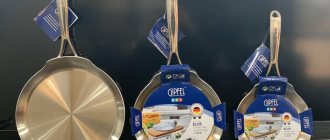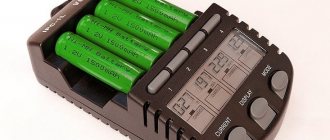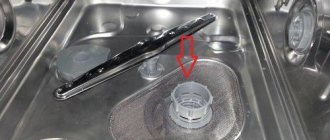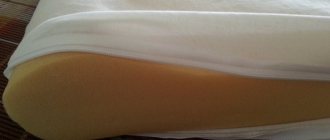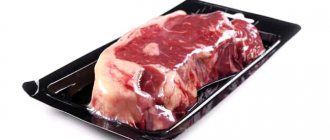How to use a dishwasher
The device washes everything from baking trays to fragile glass goblets. It all depends on the material and choice of programs. Not all materials can withstand prolonged exposure to water and high temperatures, as well as interaction with chemicals and drying with hot air.
A few recommendations for different materials:
- heat-resistant plastic can be washed without placing it in the lower basket;
- thin porcelain becomes cracked and the painting fades. Only delicate mode is suitable;
- crystal is resistant to high temperatures, but is afraid of sudden changes;
- ceramic products are washed without restrictions;
- aluminum becomes covered with a dark gray coating;
- Rust forms on cast iron.
Proper placement of dishes is the key to a quality wash.
Place dishes correctly inside the machine
The washing result often depends on the correct loading. Neglecting advice will not have a positive effect. All models have:
- upper basket - place plates, cups, glasses, glasses and various small items. In some models, you can adjust the height and select the optimal level for uniform wetting of the loaded equipment;
- lower basket - for pots, pans, baking sheets, large plates and other large items. Many machines have folding holders for even distribution of dishes. When they are folded, a flat platform is obtained;
- tray - in the form of a small removable basket for spoons, forks, knives. Premium class devices are equipped with a tray for utensils made of silver.
Choose the right washing mode
It is very important to choose the right mode after adding all the funds. Different devices have multiple programs:
- “Soak” function is suitable for pans with burnt marks or frozen fat;
- “Intensive wash” function has 2 stages - preliminary and main wash. Temperature within 65 - 70 degrees. Designed for heavily soiled equipment;
- “Standard mode” program - washing dishes with an average degree of soiling. Cycle duration is 1 – 1.5 hours at a temperature of 60 – 65 degrees;
- “Economic Washing” program implies minimal consumption of electricity and water;
- “Quick wash” mode for minor stains. The temperature is 55 degrees, but the cycle is much shorter;
- “Delicate” mode for crystal, glass, porcelain products. Temperature 40 – 45 degrees;
- The most optimal mode is “Automatic” - the device determines the degree of contamination, the number of devices and sets the desired temperature value and time.
Monitor water hardness
It is necessary to monitor the level of rigidity. Having this data, they set the required indicator on the device regulator so that the ion exchanger takes in the required amount of salt.
The sensor indicates when the salt supply in the container is running low. In this case, add more.
Take care of your dishwasher
Technology requires careful handling. Care Tips:
- after completing the process, take out the mesh filter and shake out the remaining waste, rinse under water;
The dishwasher is a kitchen assistant. - wipe all the walls of the chamber with a dry sponge;
- the door of the device is left open to completely dry the chamber and prevent an unpleasant odor;
- The dishwasher is cleaned once a quarter;
- Using anti-scale and anti-grease products, remove deposits from the structure.
Reasons for damage to metal knives
Most housewives use kitchen knives whose blades are made of steel. How can a dishwasher harm such a cooking tool?
No sharps compartment
Many dishwasher models do not have a special compartment for washing knives. If they come into contact with other metal utensils and dishes, they may not only become damaged and dull, but also leave scratches on neighboring objects.
Some dishwashers have such a compartment. Most often it is located in the upper part of the unit, where hot water does not flow.
Strong pressure and high water temperature
Another reason why the blade quickly becomes dull due to washing in the dishwasher is that the water pressure in the chamber is too intense. And although the instructions most often do not prohibit washing utensils with blades in the dishwasher, it is better not to do so. This way the service life will be significantly longer.
The thin blade of a kitchen knife can become deformed when exposed to hot water. The metal quickly becomes unusable.
Knife handles may also be damaged:
- wooden ones swell from high-temperature water and then crack when dry;
- plastic ones may crack over time.
It’s especially a pity to have expensive professional appliances damaged in the dishwasher.
Aggressive detergents
Aluminum rivets are often used to secure the handle of a kitchen knife. With prolonged exposure to an alkaline cleaning solution, they lose the oxide film that protects them from oxidation. After a few washes, the rivets may completely stop holding the handle and blade together.
We recommend: How to find out if a plastic container can be washed in the dishwasher?
How to properly clean knives
Proper cleaning will extend the life of the product. Cleaning Recommendations:
- wipe after use every time. Remove food residues. Wash off with a napkin or sponge;
- Clean with a mild detergent. Wet the sponge in a soapy solution, turn it away from you with the blade and wash off the dirt;
- if the dirt is difficult to wash off, then soak the equipment in water for 2 minutes. If left for more than 2 minutes, the blade will corrode;
- wipe dry with a clean towel, keep the blade away from you.
Proper cleaning is the key to long service life.
Can ceramic blades be washed in the dishwasher?
There are several reasons for refusing to machine wash metal blades. But what about ceramic ones? They are less whimsical, but also less wear-resistant. If you use a ceramic blade continuously, it will become dull in less than a year. And after two, you can already throw it away, since it is almost impossible to sharpen it.
Do not reduce the sharpness of the cutting edge by washing it in the dishwasher. It is enough to simply wash it by wiping it with a damp cloth and then with a dry towel.
You cannot keep a ceramic blade dirty for long. It may lose color, especially if it is light-colored. Also, the blade can be stained by the juices of vegetables and fruits, which makes it difficult to wash.
Storage and care
Tips for storage and care:
- do not store knives with other equipment;
- silverware may cause scratches and other damage;
- stored in a special stand or cases;
- care not only for the blade, but also for the handle;
- use a wooden or plastic board;
- used only for their intended purpose;
- periodically sharpen the blade;
- sharpen the blade on an abrasive stone, having previously lubricated it with soapy water;
- hunting and tourist species are not stored in a case due to moisture accumulation;
- It is forbidden to wash products with leather, bone, or wooden handles in the dishwasher;
- sharp temperature changes are contraindicated for a bone handle;
- metal and stone boards spoil the cutting edge;
- periodically lubricate with wax and oil to protect from moisture and maintain a good appearance.
Utensils made from unsuitable metal
The only metal that is 100% dishwasher safe is stainless steel. It is difficult to damage and will not rust.
Cookware made of cast iron or carbon steel quickly rusts from water. That is why it is recommended not to wash cast iron cauldrons and frying pans at all, but simply wipe them thoroughly with a cloth. Enameled cookware can be washed in the dishwasher, but over time this can also damage the enamel.
Don't put aluminum cookware in the dishwasher: it will become dull and blackened, with dull white dry spots. Aluminum is one of the softest and most “responsive” metals; it reacts not only with alkalis and acids, but also with water. To prevent this, manufacturers coat it with a protective oxide layer. But dishwasher detergents contain phosphates, which can destroy the coating. This does not make the food harmful, and the dishes can be used, but they will look unsightly and will last less.
Metals that are prone to tarnishing (copper and brass) are also best not used in the dishwasher. At a minimum, they will lose their shine when exposed to harsh detergents.
Do not put non-stick pans in the dishwasher. Residues of food can be easily removed from such a surface with a regular damp sponge, and the non-stick layer can be easily damaged in a machine.
Bottom line
Taking into account the tips and recommendations, we can conclude that it is theoretically acceptable to wash knives in the dishwasher. But in practice, it is better to do this manually, so as not to damage the blade and equipment parts.
Previous
Kitchen knivesRating of kitchen knives: 9 best models for the kitchen
Next
Making knivesHow to make a Kukri knife with your own hands: 5 steps to creating a legendary blade
Tips for proper care
To ensure that your knives last a long time, you should keep in mind the following rules for use and care:
- Use a separate device for each purpose. A knife for cutting meat fillets can be damaged by cutting bones. And a butter knife will be forever ruined by cutting fish.
- The knife must be stored in a drawer, wrapped in paper or cardboard. This way it will absorb excess water and the blade will not be damaged by other devices.
- It is better to use wood and plastic cutting boards. Boards made of ceramics, glass, and marble wear out very quickly and damage the blade. The best option is thickened paper or soft cardboard.
- It's easy and convenient to store sharp utensils on a magnetic holder that can be installed directly on the kitchen wall.
READ Where can you buy a refrigerator for cosmetics?
So, it is better not to wash either expensive professional knives or cheap Chinese knives in the dishwasher. The brutal environment in the car will quickly ruin any blade or handle. It’s easier, safer and faster to simply rinse the knife, wipe it with a dry cloth and put it away until further use.
Can knives be washed in the dishwasher?
Many experts believe that knives can become dull in the device. This is facilitated by the strong water pressure in the device. Manufacturers of kitchen tools indicate which products can be washed in the device.
Also, a sharp blade can damage the blades of the equipment. Detergents are highly acidic and may cause rust.
Sources:
https://samura-online.ru/articles/myt-nozhi-v-posudomoechnoj-mashine.html https://mashmaster.ru/mozhno-li-myt-nozhi-v-posudomojke/ https://vashnozh.ru /polezno/nelzya-myt-nozhi-v-posudomoechnoy-mashine
Why shouldn't you do this?
Experts say that knives be washed in the dishwasher. And why not is not always explained. There are actually quite a few reasons. The main reason is due to the fact that the metal and ceramic blades in the machine deteriorate. Whether knives get dull in the dishwasher is a controversial issue, but the fact that their blades become deformed from high temperatures is a fact. You also need to take into account that metal knives, after repeated washings, begin to become corroded and fail in the very near future.
There are also problems with knife handles. Products with wooden handles become unusable after 2-3 washes, since hot water and detergents cause the wood to swell and crack. Chinese knives with plastic handles also deteriorate quickly. 8-12 washes are enough and such a knife can be thrown away.
The most offensive thing to lose in this way is expensive Japanese knives, a set of which costs as much as a dishwasher.
Some housewives claim that ceramic knives can be washed , but metal knives cannot. Our experts tested this statement and found that ceramic knives deteriorate even faster in the dishwasher than metal ones.
- Three new ceramic knives were taken and washed three times. Their blades are laser sharpened so they are perfectly sharp.
- After the first wash, the knives did not change at all.
- The second wash showed some degradation of the cutting edge, but still the knives still performed their function tolerably.
- After the third wash, the ceramic knives could no longer cut the soft loaf of bread normally; they shredded it.
What can't be washed in the dishwasher
Of course, our experiment cannot be called pure, since too few products took part in it. But we have drawn a conclusion for ourselves, although we will not force it on you. Housewives also claim that knives deteriorate in the dishwasher due to contact with other utensils. This may be partly true, but the fact is that a knife in a machine will definitely deteriorate over time, even if it is placed separately in a cutlery tray, so you should not do this.
There is another interesting statement that you can listen to. Experts say that an ordinary metal kitchen knife can be washed in BEKO and any other dishwashers if its blade is rinsed once in citric acid. In this case, the blade will hold an edge better, and its anti-corrosion protection will increase approximately three times. How to bleed a metal knife into citric acid?
- Take a half-liter metal mug with hot water.
- Pour three tablespoons of citric acid into it and mix thoroughly.
- We soak a cotton swab in alcohol and degrease the blade.
- Dip the blade into the acidic solution and keep it there for about an hour and a half.
The blade should be covered with a layer of black coating. After completing the procedure, the blade should be wiped with a swab soaked in sunflower oil and then washed. From now on, such a knife can be washed in the dishwasher, provided that it has a handle that is resistant to aggressive environments.
How to properly wash knives
Washing a knife is the easiest thing to do. dishwasher for this . If you do not allow food debris to dry on the blade, then washing will be reduced to rinsing the knife under warm running tap water and wiping it with a clean, dry towel. It's another matter if the dirt is firmly stuck to the blade. In this case, the knife must be placed in a suitable container, filled with hot water and dishwashing detergent and held for 2-3 minutes. After this, the knife can be rinsed and all the dirt will come off.
Keep your knife clean and dry, and adjust its sharpening on time, and then it will serve you well for many years.
What we said concerned metal knives. Ceramics are even less whimsical, but they are also short-lived. Even a good ceramic knife, with constant use, loses its former sharpness after just a year. After two years, such a product can be safely thrown away, since it will no longer be possible to sharpen it again. The ceramic blade is not afraid of rust, but it must be protected from mechanical damage. In addition, a light-colored blade may lose color if the knife is kept dirty for a long time. It should be borne in mind that the juices of fruits and vegetables can stain the ceramic blade, so it will be problematic to wash it later.
READ Can a cast iron skillet be placed in the oven?
To summarize, we note that it is better not to wash cheap Chinese or expensive professional kitchen knives in the dishwasher. Under the influence of the aggressive environment created in the washing chamber, any knife degrades quite quickly. It is better to rinse it by hand, wipe it with a cloth and put it away until next use. Good luck!
Monitor water hardness
It is necessary to monitor the level of rigidity. Having this data, they set the required indicator on the device regulator so that the ion exchanger takes in the required amount of salt.
Choose the right washing mode
It is very important to choose the right mode after adding all the funds. Different devices have multiple programs:
- the “Soak” function is suitable for pans with burnt marks or frozen fat;
- The “Intensive wash” function has 2 stages - preliminary and main wash. Temperature within 65 - 70 degrees. Designed for heavily soiled equipment;
- “Standard mode” program – washing dishes with an average degree of soiling. Cycle duration is 1 – 1.5 hours at a temperature of 60 – 65 degrees;
- the “Economic Washing” program implies minimal consumption of electricity and water;
- “Quick wash” mode for minor stains. The temperature is 55 degrees, but the cycle is much shorter;
- “Delicate” mode for crystal, glass, porcelain products. Temperature 40 – 45 degrees;
- The most optimal mode is “Automatic” - the device determines the degree of contamination, the number of devices and sets the desired temperature value and time.

